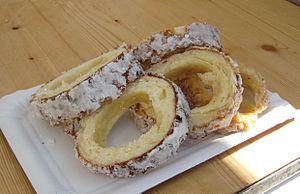Trdelník
This article needs additional citations for verification. (October 2015) |
 | |
| Type | Pastry |
|---|---|
| Region or state | Hungary, Székely Land (Romania), Skalica (Slovakia), Czech Republic |
| Main ingredients | Dough, sugar, walnuts |
Trdelník (Czech pronunciation: [ˈtr̩dɛlɲiːk]; or rarely trdlo or trozkol) is a kind of spit cake. It is made from rolled dough that is wrapped around a stick, then grilled and topped with sugar and walnut mix.
Origin
Trdelník has several origins. In the mid-19th century it was known as a Slovak dish,[1], and in the 20th century as a Moravian dish.[2][3] A similar pastry was also popular in the Hungarian speaking part of Transylvania (in today's Romania), where it is called kürtőskalács. The word trdelník is of Czech-Slovak origin; the root of this word, trdlo, is the name of the wooden tool the cake ingredients are wrapped around during cooking (which gives it its traditional hollow shape), and can also mean "simpleton" in English (see trdlo).
In the 21st century it became popular among tourists in the Czech Republic and Slovakia. Nowadays, trdelník is very popular among tourists as a sweet pastry in many countries, mostly in the Czech Republic. A variation of trdelník with an ice cream filling was popularized by Prague cafés.[4]
The version from the Slovak town of Skalica (Skalický trdelník) was registered in December 2007 as a PGI (protected geographical indication) in the European Union.[5] The registration application with the detailed description of the product was published in April 2007 in the Official Journal of the European Union.[6]
Tourism in Prague
Although trdelník is usually presented as "a traditional Czech cake" or "the old Bohemian pastry", and mentions of "český trdelník" can be found in 20th century literature,[7] trdelník is mostly mentioned in literature as a Slovak or Moravian, not Bohemian dish, and the mass spread of this dessert in Prague is recognized to have started more recently. Czech cinematographer and reporter Janek Rubeš argues that trdelník is only made for tourists, and that even the hamburger is more traditional in the Czech Republic.[8]
Skalický trdelník
The production of trdelník has a long tradition in the Slovak town of Skalica near the border with the Moravian Slovakian town Hodonín. The original recipe was owned at the end of the 18th century by the cook József Gvadányi, a retired Hungarian general and resident of Skalica. The original recipe then was improved by the inhabitants of Skalica to its final form now known as Skalický trdelník.
The society Skalický trdelník was founded in 2004 with the goal of keeping the tradition of the original open fire Trdelník production.
Similar products


 Hungary - Known in Hungary as Kürtőskalács
Hungary - Known in Hungary as Kürtőskalács Austria - Known in Austria as Prügelkrapfen
Austria - Known in Austria as Prügelkrapfen Germany - Known in Germany as Baumstriezel
Germany - Known in Germany as Baumstriezel Luxembourg - known in Luxembourg as Baamkuch, has become a traditional dish served mostly on special occasions, such as weddings.
Luxembourg - known in Luxembourg as Baamkuch, has become a traditional dish served mostly on special occasions, such as weddings. Poland - Sękacz is a similar cake also cooked on a spit, normally over an open fire.
Poland - Sękacz is a similar cake also cooked on a spit, normally over an open fire. Lithuania - Šakotis or Raguolis (Bankuchinas as known in western part of Lithuania) is made similarly but looks, tastes and is eaten completely different.
Lithuania - Šakotis or Raguolis (Bankuchinas as known in western part of Lithuania) is made similarly but looks, tastes and is eaten completely different. Romania - Colac secuiesc is a similar cake also cooked on a spit.
Romania - Colac secuiesc is a similar cake also cooked on a spit. Turkey - Known in Turkey as makara
Turkey - Known in Turkey as makara Israel - Known in Israel as kyortush
Israel - Known in Israel as kyortush South Africa - Known in South Africa as stokbrood
South Africa - Known in South Africa as stokbrood
See also
References
- ^ Časopis Českého Musea. XXII/2. 1848. p. 331.
- ^ Moravské národní pohádky a pověsti. 1983. p. 334.
- ^ Vlastimil Vondruška, František Skála (jr.) (1991). Církevní rok a lidové obyčeje. p. 88.
- ^ Tennent, James (1 March 2016). "Chimney cake: The doughnut ice cream foodporn oozing over your Instagram". Ibtimes.co.uk. Retrieved 15 December 2017.
- ^ "EUR-Lex - 32007R1485 - EN - EUR-Lex". eur-lex.europa.eu. Retrieved 15 December 2017.
- ^ "EUR-Lex - 52007XC0421(02) - EN - EUR-Lex". Eur-lex.europa.eu. Retrieved 15 December 2017.
- ^ Zvon: týdenník beletristický a literární. 1930. p. 153.
- ^ "5 TRUE FACTS ABOUT TRDELNÍK (Honest Guide)". youtube.com. 2018-10-12.
External links
- History of trdelník
- Jůn, Dominik (August 23, 2014). "The 'Old Bohemian' Trdelník". Czech Radio 7, Radio Prague.
